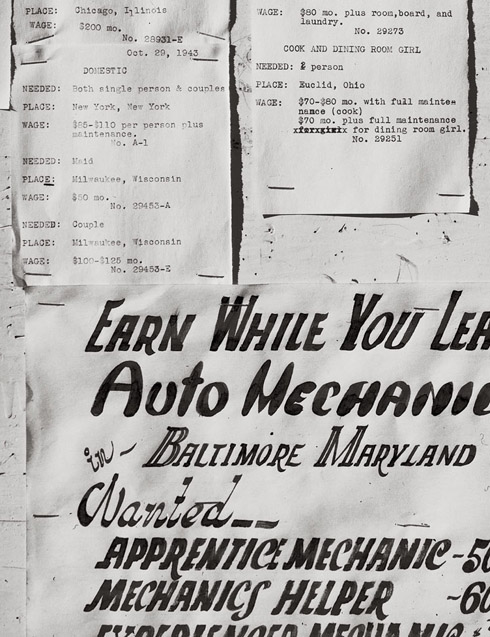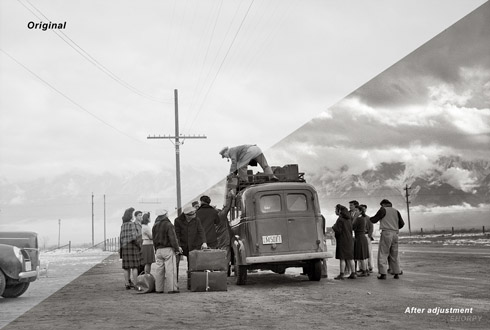


Framed or unframed, desk size to sofa size, printed by us in Arizona and Alabama since 2007. Explore now.
Shorpy is funded by you. Patreon contributors get an ad-free experience.
Learn more.

- Freeze Frame
- Texas Flyer wanted
- Just a Year Too Soon
- WWII -- Replacing men with women at the railroad crossing.
- Yes, Icing
- You kids drive me nuts!
- NOT An Easy Job
- I wonder
- Just add window boxes
- Icing Platform?
- Indiana Harbor Belt abides
- Freezing haze
- Corrections (for those who care)
- C&NW at Nelson
- Fallen Flags
- A dangerous job made worse
- Water Stop
- Passenger trains have right of way over freights?
- Coal
- Never ceases to amaze me.
- Still chuggin' (in model form)
- Great shot
- Westerly Breeze
- For the men, a trapeze
- Tickled
- Sense of loneliness ...
- 2 cents
- Charm City
- What an Outrage
- Brighton Park
Print Emporium
Leaving Manzanar: 1943

"Loading bus, leaving Manzanar for relocation. Manzanar Relocation Center, California." Large format nitrate negative by Ansel Adams. View full size.
A nice name
"Relocation center" is a nice name for something that practically is a concentration camp.
[Hardly. Read up. And down. - Dave]
Relocation Awareness
There was no mention of this in my mid-50's California grade-school textbooks, though I had heard some vague references about it from my father (a WW2 vet and California native) over the years. The full scope of what had gone on seems to have first come to me around the time of Earl Warren's retirement from the Supreme Court in 1969 when the retrospectives on his public life mentioned the key role that he'd had in the policy (and that it had affected US-born citizens and not just foreign-born enemy aliens).
Scope of Awareness
The Manzanar Relocation Center is a fascinating and controversial part of U.S. history, obviously. I don't recall there being a single mention of this while I was in high school - in fact I think I first heard about it in an interview with George Takei of all people. Although there was a great deal of hardship in these centers, there was a great deal of patriotism and ingenuity as well.
Has anyone seen the 1976 TV film "Farewell to Manzanar?" I've only read about it, and it hasn't been released on home video.
Leaving Manzanar... going where?
Yes, they are leaving Manzanar -- to be relocated. Internees were not freed from the camps until January 1945. And then what future did they have? Many of these Americans lost their homes and livelihoods as a result of the internments. Many had sons who fought bravely -- and died -- in Europe for their country. It's a testament to the loyalty to Japanese-Americans that their treatment at the hands of their government did not incite hatred of it.
One of my grad school professors was James D. Houston who wrote Farewell to Manzanar with his wife, Jeanne Wakatsuki. It's an affecting story, and tells you the story of what happened to these families from a personal point of view.
[They're probably heading east. You were free to leave if you had somewhere to go other than the West Coast. The point of the relocation camps was to relocate you away from California. Aiko Hamguchi left for a job in Detroit. The job boards at the camps listed hundreds of employment opportunities in the East and the Midwest. - Dave]

The Evacuation
The paranoia that gripped the US was mostly uncertainty about how those who belonged to a very closed knit and unknown culture would respond when their country of origin was at war with the US. Even though so many were citizens, would they sabotage the US war effort? The Japanese were known for fierce loyalty and dedication. Their culture has always been extremely ethnically oriented. FDR made the call and it's easy to say it was bad in hindsight. Standards of political correctness have changed dramatically and we're viewing it from the safety of many decades. War is always terribly destructive and unpredictable.
That being said, I realize that some of the children in these pictures may well have ended up as friends of my family twenty or so years later.
[A specific concern on the West Coast was unease about the reaction of Japanese Americans to the giant bomber assembly plants being built by the aircraft manufacturers in California. Basically factories devoted to killing as many of their relatives and former countrymen as possible. Another concern was infiltration by saboteurs or spies from Japan who might try to hide among the Japanese American population. - Dave]
Manzanar Relocation
Did American citizens of Japanese descent really deserve the treatment they received? That photo speaks volumes about the paranoia that gripped both Canada and the United States.
Sad. Sad. Sad.
[It's hard to overstate the effect Pearl Harbor had on America. And these people are leaving the camp, not going in. - Dave]
Makes me wonder
Makes me wonder if what we're seeing is what the original photographer intended or saw himself.
[His intent was to take a picture and make the print we see in the second of the two photos below. - Dave]
The Zone System
Ansel Adams! Now you're talking! Look at the detail in the shadow areas as well as the highlights. This man took his photography very seriously.
[That's more the Photoshop Shadows & Highlights filter than anything Ansel did. This is the (positive) version of the original negative after being adjusted by me for contrast. Unadjusted, it's kind of washed-out looking (click below to enlarge). - Dave]
Below is a scan of the gelatin silver print Ansel made from the same negative. Click to enlarge.
The take-home message here is that digital images (the pictures you see here on your computer display), made from the original negatives and transparencies, show far more detail than scans of a paper print, or even a paper print viewed in person. Which is what Shorpy is all about. Decades after these photos were taken, they are only now realizing their full potential.


























On Shorpy:
Today’s Top 5